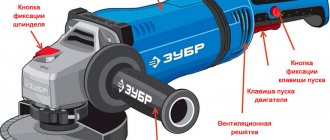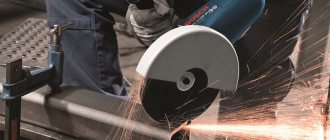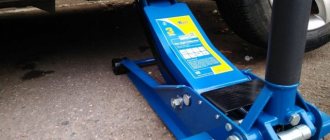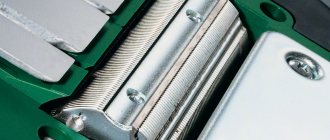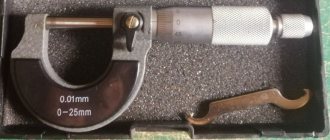How to use a jack: general operating rules
Like any other technical device, the jack requires compliance with safety precautions during operation. Its use is not difficult, the main thing is to know where to put the jack and what to do with it next. This is far from a new device; most samples have been tested by time and personal experience.
Classic rack and pinion jack
Driver's courses do not teach how to properly use and install this device. You need to study everything yourself. In addition, most people, not knowing clear rules, believe that with its help you can not only lift and lower a load, but also hold it for a long time. To avoid possible health risks, you need to learn how to install a jack correctly.
A specially developed list of rules can help with this:
Jacks exist in three types: mechanical, hydraulic and pneumatic (inflatable). Each of these types has its own specific operating rules.
Why doesn't the bottle jack work?
There is little oil in the tank, the rod does not rise to the height specified in the technical documentation. To repair it yourself, we just need to add oil. Open the oil filler cap, fill it, then pump the jack, as described at the end of the article.
Oil is leaking. It happens that oil leaks in places, rubber bands and seals, this is the first sign that a major repair needs to be made, all gaskets and seals need to be replaced, and a flush must be carried out. To repair a hydraulic bottle jack yourself, you will need a repair kit.
It sags under load. Occurs due to the air inside; one of the rubber bands or gaskets allows oil to pass through and instead air enters the working chamber, which tends to compress strongly under load. To eliminate the problem, it is recommended to repair the jack, change all gaskets and fill in new oil.
How to Use a Rack and Screw Jack
When using rack and screw jacks, the above rules and recommendations, plus some specific ones, apply.
Screw device
Rack and pinion devices, like screw devices, have become widespread due to their simplicity of design. They are mainly popular among off-road enthusiasts. The design of such devices allows you to lift a lot of weight, which plays a decisive role. They can be used in any conditions due to their unpretentiousness and small dimensions, which is an advantage compared to hydraulic lifts, which are massive and take up a lot of space in the trunk.
Safety precautions when working with rack and pinion devices:
Bottle jack device
As can be seen in the figure, the hydraulic bottle jack consists of the following parts:
1. Main piston
4. Suction valve
5. Shut-off valve
6. Oil storage tank.
7. Working chamber.
When a force is created on the lever (2), the rod (3) creates pressure, as a result of which the valve (5) opens, and the liquid flows into the working chamber (7). When the lever is lifted up, the shut-off valve (5) closes and liquid is drawn into the pump cavity from the oil storage tank (6) by opening the pressure of the suction valve (4). By pumping liquid from the reservoir (6) into the working chamber (7), the main piston (1) is raised.
The work design uses the well-known Pascal's law: The pressure exerted on a liquid or gas is transmitted to any point without changes in all directions.
The design of a bottle jack is quite simple; we pump liquid from one reservoir to another, and thereby build up pressure in the second, thereby raising the working piston.
Maintenance Recommendations
Any maintenance should be carried out in a specialized service center, especially for complex hydraulic mechanisms that require periodic oil changes, and for this the jack will have to be disassembled, so it is better to entrust this work to professionals.
Using a jack is simple, but you should know safety precautions and be careful, because human health depends on its proper operation. A rack and pinion jack such as a hi-jack is especially dangerous.
Source
OCCUPATIONAL SAFETY REQUIREMENTS AFTER WORK COMPLETION
5.1. At the end of the work, the worker using the jack must: - release the jack from the load, clean it from dust and dirt and bring it into the transport position; — place the jack in the place designated for storage (transportation); — remove additional devices (tragus, support platforms or half-rings) to storage areas, having previously cleaned them of dust and dirt; — inform the engineering and technical worker responsible for maintaining the jack in good condition with information about defects and malfunctions of the components and elements of the jack identified during the work. 5.2. Take off overalls, safety shoes and other personal protective equipment and deposit them in the prescribed manner. 5.3. Wash your face and hands with warm water and soap or take a shower. 5.4. When handing over your shift, you should inform the shift worker about any problems with the jack’s operation.
Carville › Blog › Instructions for installing a jack. We give products to test for review!
Almost every motorist has a diamond jack in the trunk. In theory, everyone knows that with its help you can lift the car to change a wheel or do a seasonal tire change yourself.
But not everyone knows how to properly use a jack in practice. As part of the “Carville Repair School” project, AIRLINE technical control department expert Igor Gorelov tells and shows how to use a diamond jack effectively and safely. For example, we used the AIRLINE AJ-R-02 diamond jack.
Where to install the jack
Before placing the jack under the bottom of the car, put the gear in first gear and raise the handbrake (if the gearbox is automatic, then put the gearshift knob in the “park” position). The jack itself must be placed on a dry, hard and level surface.
The installation location of the jack is indicated by special stampings on the thresholds: some cars may also have a triangle image on the threshold, while others may have these “notches.” It is for them that the thrust pad of the jack needs to be placed.
Consequences of incorrect installation
If the jack is installed incorrectly under the bottom of the car (not in the designated place, not on a hard surface, not strictly vertically, but at an angle, etc.), this will lead to dire consequences. Under the heavy weight of the car, the jack will tip over or break.
How to lift a car
Install wheel chocks under the wheels. We remind you once again that you need to put the first gear and raise the handbrake (if the gearbox is “automatic”, then put the gearshift knob in the “park” position). If you need to remove a wheel, remove all the nuts and loosen the bolts before lifting the car. After you raise the car to the desired height, unscrew the bolts completely.
Secure the lever and turn it to the right until the wheel leaves the ground. The wheel can now be removed for replacement or repair!
Features of AIRLINE jacks
All AIRLINE rhombic jacks have a reinforced synchronizer - a unit that provides force for the simultaneous lifting of both rods. They also have a bearing on the threaded axle, which facilitates the torsion of raising and lowering: many models of diamond jacks have a simple washer installed, which is quite difficult to turn.
The side parts of the jack in the area of the threads are tightened with bolts for reliable fixation of the frame - jacks from other manufacturers have only rolling in this place, which after several lifts spreads in different directions. Several models of AIRLINE jacks have a rubber pad for the thrust pad, which prevents the machine from slipping when lifting.
The manufacturer provides a 1-year warranty on all jacks. The jacks are powder coated to protect the metal from rust. The lever handles have rubber tips for comfortable operation. More information about AIRLINE jacks here.
We give products to test for review!
You can test the AIRLINE jack for free in exchange for an honest review of our products on your Drive2 blog. Write to us in the comments to this article to take the products for testing.
Subscribe to the Carville Repair School Youtube channel
Download our application for IOS and Android - the entire product catalog in your smartphone!
Source
How does a bottle jack work?
We will look at the operating principle of a hydraulic jack using the example of their most common type - a bottle plunger hydraulic jack. They come in different lifting capacities - 3 tons, 5 tons, 10 tons, etc.
Everything is quite simple: there is a piston in the cylinder and either in a separate reservoir or in the same cylinder above the piston there is hydraulic oil - the working fluid of the jack.
The hydraulic jack is activated by a plunger - a small pump that forces oil through a bypass valve into the cavity under the piston. Due to the difference in diameters of the plunger and the jack cylinder, the applied force is minimized. The liquid pumped under the piston pushes it out, lifting the load above it.
Lowering the jack is accomplished by slowly bleeding hydraulic oil from under the piston into the top of the cylinder or reservoir.
This is the principle of operation of all hydraulic jacks.
Another thing is that not all of them are equipped with a plunger pump, and the role of a plunger can be either a separate hand-held device connected to a jack or a hydraulic station.
And now is the time to take a closer look at the types of hydraulic jacks, places and methods of their use.
mathvich › Blog › I can jack up like crazy. Instructions for beginners on jacking up a car.
In this post, I want to share my experience mixed with factory recommendations on how to and should NOT jack up your favorite cars.
First: in any tire shop, in any service, always check BEFORE lifting the car where the workers put the jacks/lift legs. The threshold can only be crumpled or not crumpled, and between these states there is exactly one act of lifting the car. If the lifter's foot slips off the seam, the threshold will immediately be pressed through (I've seen this more than once). A straightened threshold and an initially intact one are not the same thing.
What you definitely can’t
:
1)
You cannot jack up the center of the sill to change both wheels on one side at once.
The tire fitter is too lazy to push the jack twice, and your threshold may come to an end (maybe not the first time, but you definitely can’t
). At risk: schoolchildren who have watched enough on YouTube where cool guys change tires at races in one lift. There are several explanations: either they have a missl with overcooked reinforced thresholds, or the car is so lightweight that it doesn’t push through, or they don’t care. If you try to lift your poor GX81, 90 or 100 like this, then the sill edge deflection will not take long to occur. Don't ever do that.
2)
Do not use a rolling jack without a sufficiently thick rubber cushion. Most jacks are sold without a cushion. Hamsters think that it is not needed. But if they sold you skis without boots, would you squeeze your fingers into the bindings just like that? The pillow is a consumable and is sold separately (it costs 150 rubles). The jack manufacturer doesn’t care about your thresholds, they have a different goal - the jack should jack you up and cost as little as possible. So buying a pillow is your task. The same thing happens at tire shops and services - if there is no cushion on the lift or jack, or it is very worn out and the threshold rises iron on iron - abandon the repair idea in this place. Or offer to change the pillows before the lifting procedure. Again, nothing noticeable will happen at one time, but do you need to get it fixed in such a service? And begin the destruction of your threshold, which is either intact or not.
3)
The standard diamond-shaped jack cannot be used. This little thing is placed in the car as a last resort. If you have a flat tire on the highway and just can’t get to the tire shop, then you can lift the car and put it on. But I would prefer (let’s say in the city) to do nothing and get there on a broken tire. Maybe 5, maybe 10 km (although in fact I drive a rolling jack with a cushion and could change a tire, but only if the road is not busy and it is daylight). I don’t care about punctured tires; they may not be repairable anyway. But the threshold will not be damaged. And I won’t have to change a tire on the side of the road; even a small chance of being hit by some idiot doesn’t suit me. I don’t care about this tire, I’d rather live and buy a new one than drive on a sealed one with holes and squirm under the car on the side of the road.
How to jack correctly:
An obvious point, but nevertheless useful for absolute beginners: the threshold of a car is a box-shaped section of the body, located at the bottom of the doorways between the wheels. At the bottom there is usually a seam, a piping:
The jack is inserted exactly into the edging and only along the edges of the threshold in places marked with small cutouts. Attention: the rear part (trunk) is not a threshold! You cannot place a jack behind the rear wheel (I wouldn’t write this if I hadn’t seen the trunk niches dented by the jack). Although the threshold looks generally uniform, on many cars it is reinforced only in designated areas. If you place a jack in the middle, the threshold will not hold up and will collapse. This is unsightly, besides, it reduces the safety of the car in an accident and causes corrosion.
Also, before jacking the car, it is important:
1) Make sure that the car is not standing on an inclined plane and does not roll on its own in neutral and without the handbrake. 2) Turn on the handbrake. 3) Loosen the wheel nuts in advance before lifting. A small shift of half a turn is enough. This is done to prevent the car from falling off the jack due to a jerk. 4) Place wheel chocks (or at least any lugs) under the wheels.
The main principle of raising a car:
An old joke from traffic rules exams: - What to do if you are standing in the center lane, and you needed to turn right from the right lane?
- Nothing. Go straight! If you are not already in the turning lane, then you CANNOT turn. Same with a jack. If you do not have a suitable jack, then you simply should not lift your car under any circumstances (except for emergencies that affect people's health).
It’s better to forget about the jack in the sills altogether; lift the car with 4-arm lifts. If you really want to, a rolling jack can be placed according to the car manufacturer’s recommendations: for example, Mark 2 can be lifted under the rear gearbox and under the front subframe.
Source
Design Features
Each subtype of hydraulic jacks has its own design features, and even devices of the same category may have some differences. The only and unchanged element of all such devices is the rod lifting mechanism itself. To a person with minimal knowledge of mechanics who does not understand the terminology, the device may seem complicated, but in fact, its principle is quite simple. To understand how a hydraulic jack works, it is enough to know what parts it consists of and how they interact with each other.
1.Lever arm
.
Plays a major role in pumping liquid inside the device, from one reservoir to another. 2. Plunger
.
Moves with the handle. When moving up, it picks up liquid from one reservoir, and when lowering, it pushes it into another, creating pressure under the rod. 3. Piston
.
The base of the rod, tightly adjacent to the walls of the cylinder. It rises due to the liquid entering underneath it, causing an increase in pressure in the tank. 4. Stock
.
It goes along with the piston and is the final element of the entire structure, resting against the required load. 5, 6. Check valves
.
Allow liquid to move in only one direction, from one reservoir to another, without flowing back. For example, valve 5 opens when suction (vacuum) is created in the compartment with the piston, and closes when pressure is generated. The 6th valve acts in reverse, closing when liquid is sucked in, and opening when feeding. 7. Bypass valve
. An important design element necessary to normalize pressure by opening the valve between two tanks. Lowers the rod if there is a load on the latter.
Perhaps the most basic hydraulic jack is the bottle jack, since it does not use any additional elements that are lifted by a rod and rest against a load. Next in simplicity comes the rolling one, where the rod is already connected to the load-bearing platform. The most unique in terms of implementation include rhombic ones, which lift a load using 4 interconnected levers.
Ways to jack up a car correctly
Every driver who frequently travels not only on the highway, but also around the city, is familiar with the situation - a flat tire. Very lucky are those owners whose “four-wheeled” friends are equipped with a “spare wheel” and other tools for changing a wheel: the first place of which is a jack. After all, without it, even if you have a spare tire, you certainly won’t be able to replace it right on the road!
Recommendations for using a jack.
ROLL-OUT SCISSOR JACKS
Lifting is carried out by extending the piston from the hydraulic cylinder, while changing the angle between the hinged levers. Sometimes they have two lift levels, which makes it possible to lift cars with low ground clearance to a considerable height. They can be equipped with a cardan control system, a pressure valve and a carrying handle. The lifting capacity of such jacks is usually from 4 to 7 tons. (+)
Structural rigidity, mobility, low force on the drive handle, small initial height, significant lifting height.
(-)
Heavy weight, high cost, ability to work only on flat and hard surfaces.
What is a jack
This is a unit that is used during scheduled repair work, as well as when unforeseen situations arise: getting out of a hole or mud, replacing a wheel, etc. Car owners who often have to drive off-road do not allow themselves to move without this assistant. And in general, it is recommended for absolutely everyone to carry a jack with them in order to get out of an unexpected unpleasant situation “unscathed” as quickly as possible. Otherwise, you will have to call a tow truck, whose services will not be cheap. Of course, the jack, as well as the spare tire, are helpers in solving many problems. BUT! Agree, if you don’t know how to use it, you will not only not achieve the desired results, but will damage your car even more (for example, by bending the sills, etc.). And in the worst case, improper lifting can threaten to cause certain (and not always minor) injuries to the car owner.
Advantages and disadvantages of different jacks
Each type of jack has pros and cons, which determine the advisability of their use in specific situations:
- Rack and pinion - suitable for working with low-lying loads, but are unstable, have a small support area, and also inconvenient dimensions. To lift a car, the latter must have special recesses in the bottom.
- Diamond screws – compact when folded, reliable, stable. But they are characterized by a low lifting height.
- Hydraulic – stable, compact and convenient, provide quick and easy lifting of the load. In addition, they have a high efficiency index and a high load capacity. But they require regular maintenance, have a short service life, and are not capable of lifting loads to great heights.
- Pneumatic – easy to use, stable on any soil. At the same time, pillows are easily damaged by cutting or sharp objects. When using compressed air, a separate compressor is required.
The choice of a jack should be made based on what specific tasks you plan to solve with the help of this tool.
Jack installation
How effective, easy to use, and reliable your future jack will be must be determined before purchasing it! It is important, first of all, to pay attention to its maximum load capacity - this value should not be lower than the weight of the car. For example, if the weight of the TK is 800 kilograms, it is best to give preference to a device that can raise at least one tone.
Important! If your four-wheeled friend weighs more than the jack can lift, then we strongly recommend NOT using it. Such actions lead to overload, which ultimately leads to damage to the vehicle.
In addition, a car that falls off the supports can not only damage the car, but also harm your health (at a minimum, cause bodily injury).
So, the rules for lifting a car with a jack
Important! It is highly not recommended to lift cars with a plastic body kit using rack and pinion jacks! In this case, a pneumatic modification is suitable.
Note that when replacing the rear wheels, it is not necessary to use the handbrake, and to be even more precise, it is not necessary at all. Do not forget that the lifting should be carried out as smoothly as possible (regardless of the device used - mechanical, pneumatic or air). To increase the level of safety, we recommend securing the vehicle with special supports. Please note that these do not include stones, bricks or other objects...
Diamond jacks
Diamond-shaped or screw jacks are known to almost every motorist - usually these devices are included in the package of new products. Choosing such a tool for lifting a machine is very simple - you just need to decide on the load capacity, pick-up height and lifting height. Diamond jacks typically lift 1 to 2 tons, have a lift height of 300-390 mm and a lift height of 80-120 mm. The average one-ton jack provides a lift of the car by 35 cm, and a one and a half ton jack – by 39 cm. The latter is especially worth paying attention to for owners of crossovers and SUVs with high ground clearance and heavy weight.
Tips from the professionals
Yes, of course, your main tasks are to choose the right place, as well as to install the jack efficiently (of proper quality). But! Do not be too confident in yourself; before performing these operations, carefully check the reliability of the jack, and also make sure how well your “four-wheeled” friend is fixed. Well, now you know that you shouldn’t be too careless with such “everyday” things as a jack. Yes, we wish that you don’t need it, but we nevertheless recommend that you always have it at hand in case “if something happens.”
Source
Don't make dangerous mistakes!
Follow the rules, do not act at your own risk. Otherwise, you will have to resort to expensive repairs later. Under some types of jacks you need to put thick rubber as a gasket. Make sure that the area you are working on is level.
Don't forget, a jack is a tool that lifts a car, not keeps it raised. Don't make dangerous mistakes, otherwise the car may land on your foot.
Photos from Internet resources
Lifting a car with a jack, rules for installing a jack
The effectiveness and efficiency of the jack must be determined at the stage of purchasing this device.
An important indicator when choosing is the carrying capacity of the models under consideration. It is important that this value is not less than the total weight of the vehicle.
So, for a car that weighs 800 kilograms, it is advisable to place a device with a carrying capacity of 1 ton in the trunk.
However, you should not try to lift a larger vehicle with such a jack, since overloading will lead to breakdown of the lifting unit and, therefore, will cause damage to the vehicle.
Moreover, a car falling from its support can pose a significant threat to the health and life of a person who is close to it.
Rules for lifting a car on a jack and safety precautions:
The main malfunctions of a hydraulic jack and how to eliminate them
| Malfunction | Possible reasons | Remedies |
| The pump does not supply oil to the cylinder | There is not enough oil in the appliance. Loose fit of valve balls to their seats due to wear or clogging of the seats. | Unscrew the plug or breather and add oil. Check the pump valves, clean if clogged, and if the seats are worn, send for repairs. |
| Complete or partial loss of force in the device cylinders | Worn piston seals. Reduced elasticity of the safety valve spring. | Replace cuffs. Adjust or replace the spring. |
| Oil leaks from the cylinder | Worn or torn piston cuffs | Replace cuffs |
| Clamping wedges slide over the rail head | Dirty wedge grooves. Chipping of wedge notches; a generous layer of fuel oil on the rail head; large burrs. | Replace cuffs |
Places for installing a jack
When removing and installing a wheel on a car, there is always a need to use a jack or other lifting mechanism, which can be equipped at a service station or tire shop. When installing a spare tire or changing wheels for the season, the motorist himself is often faced with the need to use a jack. When replacing a wheel yourself, you usually use a screw, hydraulic or rack jack, which is usually included in the set of necessary tools supplied with the car. In tire shops or service stations, hydraulic rolling or pneumatic jacks are usually used; specialized lifting stands and hydraulic mechanisms equipped with an automated control system are often found.
When using a jack in case of changing a wheel yourself, you must clearly determine the location for its installation. Usually, the places for installing the jack are marked in the illustration in the technical documentation for the vehicle, but in the absence of such documentation, you can determine them yourself without much difficulty.
For example, on most domestically produced cars, this place is a small area on the threshold, located in close proximity to the wheel and, as a rule, reinforced with a metal profile or plate. On foreign-made cars (Japanese, French, American, etc.), this place is marked with special recesses; in addition, on many foreign luxury cars (in Russia these are mainly German cars), the place for installing the jack is indicated by arrows or triangles and has a special rubber cushion that protects the threshold from possible damage.
In the case when the threshold of the car is rotten or deformed, as well as when it is necessary to lift two wheels at once (which is quite often used in tire shops when changing tires seasonally), it is permissible to install a jack under another load-bearing part of the body, which may be the lever support, the end part shock absorber struts, gearbox (on jeeps and gazelles), beam, load-bearing part of the bottom, etc.
When installing a jack under heavy cars such as Jeep, UAZ, Gazelle, as well as under some crossovers and station wagons (and sometimes sedans of some brands), you should carefully inspect the front and rear of the car under the bottom in order to detect a load-bearing support or beam , having a designated area for mating with the jack cup. In this case, two front or rear wheels will be lifted at once. In no case should a jack be installed under the sill on heavy vehicles, as this will inevitably lead to its deformation.
Device and design of a hydraulic jack
The capabilities of hydraulic jacks are strikingly different from those of both mechanical and pneumatic counterparts. Key Features:
- load capacity from 1.5 to 200 tons (in some cases - up to 1000 tons);
- high efficiency - close to 80%;
- low working effort;
- smooth ride;
- high structural rigidity.
The disadvantages of most hydraulic jacks include the initially large height of most devices and the need for maintenance during operation.
Installing a jack on a Hyundai Creta
But it happens that you lift the car not on a jack, but on a lift. Unfortunately, not all craftsmen install the lift legs correctly, which leads to bending of the thresholds. To prevent this from happening, it is recommended to install the paws in special places on the Hyundai Creta thresholds. These places are reinforced, which prevents them from bending when the car is lifted. The diagram below shows a schematic representation of the installation location of the jack on a Hyundai Creta:
That's all. I hope this article will be useful to you and, after reading it, you will correctly install the Hyundai Creta jack in place and not damage the sills when lifting the car. See you again on our website.
How to fill the oil and bleed the jack?
Oil is poured through the neck on the side of the housing. This same neck is a level. Fill the oil, then you need to bleed the jack.
- Raise the rod to the highest position without load using a lever
- Then it is placed on its side, the filler plug should be on top
- The plug is loosened and the rod is vigorously pressed into the cylinder. The operation is performed to squeeze out air from the working chamber.
- The plug is closed, and 10-15 full lifts and lowerings of the rod are performed with a load of 40 - 45 kg.
- At the last cycle, you should give an increased load and if the jack does not hold, repeat the procedure.
Where to put the jack on the Hyundai Creta?
When using a jack for the first time, many owners have a completely reasonable question: “Where to put the jack on the Hyundai Creta?” You won’t see standard jacks on the Creta, since they simply aren’t there. Or rather, they practically do not stand out.
But if you pay attention to the persistent part of the jack itself, you will immediately understand where to place the jack on the Hyundai Creta. On the thrust part of the jack there is a special groove for the threshold flange.
The photo below shows the places for the Hyundai Hreta jack:
To prevent the thresholds from bending due to the standard diamond jack, install the jack exactly as shown in the photo above. Otherwise, you may bend the sills when lifting the car.
Types, properties and characteristics of hydraulic bottle jack
Jacks are divided into several types, the first division is based on the number of rods (half-rams):
- Single-stem bottle, the most common type Fig. 2.
- Double stem bottle Fig 3.
There is also a division based on the operating principle of the pump pumping liquid:
- Manual, activated by user pressure on the lever
- Large pumps designed to lift enormous masses are driven by a separate drive, hydraulic pump or hydraulic station.
Properties:
Load capacity is an important parameter that determines the maximum liftable weight. The parameter depends on the volume of the working chamber and strength characteristics. Bottle-type devices have a load capacity from 2 to 100 tons.
The minimum lifting height, otherwise called the minimum pick-up height. This is the height at which the load must already be in order to be able to place a jack under it. Please pay attention to the minimum height if you are selecting a device for a car. If you have low ground clearance, then a bottle-type device due to its high design will not suit you.
Maximum lift height. The height to which a load can be lifted. The bottle ones have a special feature: on the support platform there is a retractable screw that increases the minimum and maximum lifting height.
Maintenance of rolling hydraulic jacks
Proper use and proper care will extend the trouble-free operation of the jack - the lifting device should not fail at the most important moment.
If the stroke of the rod is not smooth, the car does not rise smoothly, jerkily, the lifting speed is reduced, you need to make a lot of effort when you press the lever - these signs indicate that urgent measures are needed and prevention alone will not do.
In order not to take forced urgent measures, you need to constantly maintain the jack. Caring for a load-lifting device is not complicated and does not require much time, so that not only the service life is increased, but also the safety guarantee.
Adding oil is the main condition for trouble-free operation of the device. Oil leaks out in small quantities through the seals during operation. To add oil, place the jack on a flat surface, lower the lifting mechanism and unscrew the cap in the oil filler hole. After this, add the required amount of oil. When the mechanism is used intensively, dirty oil must be changed periodically. When adding and replacing, you need to use only high-quality oils:
- industrial oil – I-20;
- hydraulic – Total LHM+;
- for automatic transmissions;
- for shock absorber struts – MGP-10.
Important! When carrying out work, do not mix different mixtures and allow foreign liquid to enter the hydraulic cylinder!
Removing excess air from the hydraulic cylinder is a condition for high performance of the jack. Air bubbles in the hydraulic cylinder are formed at the slightest oil leakage through the seals or due to untimely topping up. To release air, unscrew the cap on the oil filler hole and, with the bypass valve open, quickly press the lever. Air is forced out of the oil when pumped by the built-in pump.
Regular lubrication of rubbing metal parts is the main condition for reducing jack wear.
Constant monitoring of oil leaks, inspection of wheels, checking the reliability of their fastening is the key to trouble-free operation of the jack.
Store the jack in a dry place : corrosion due to contact with moisture is the enemy of the metal parts of the jack.
The need to lift loads to a small height without moving them has always arisen. Previously, several people with different devices were involved for these purposes. But with the invention of the jack, lifting became possible for one person. Hydraulic jacks are widely used. They are used both at home and in production. They differ in load capacity, design, lifting height and dimensions. The principle of operation is the same for everyone.
The main purpose of a hydraulic jack is:
- lifting a load;
- fixation at a given height;
- movement.




